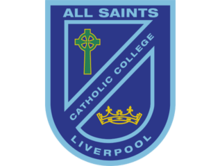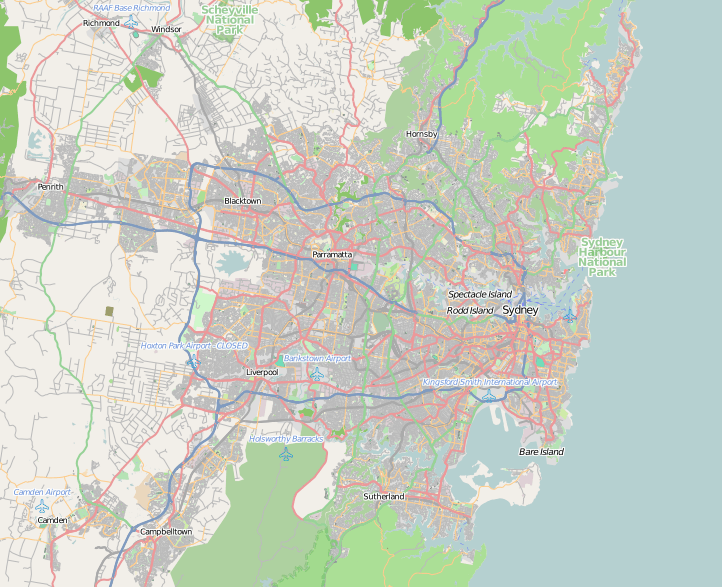All Saints Catholic College, Liverpool
All Saints Catholic College, Liverpool is an independent Roman Catholic co-educational secondary day school located in the south-western Sydney suburb of Liverpool, in New South Wales, Australia.[1] The college was created in 2016 through the merger of the All Saints Catholic Boys' College and the All Saints Catholic Girls College and provides religious and general education for students in Year 7 to Year 10. The boys' school was originally called Patrician Brothers College, Liverpool. One of the feeder schools in the All Saints Catholic Primary School, located adjacent to the College. Some students progress to the All Saints Catholic Senior College, located in the adjacent suburb of Casula.
| All Saints Catholic College, Liverpool | |
|---|---|
 College crest | |
| Location | |
 All Saints Catholic College, Liverpool Location in greater metropolitan Sydney | |
Australia | |
| Coordinates | 33°55′6″S 150°55′40″E |
| Information | |
| Former name |
|
| School type | Independent co-educational secondary day school |
| Motto | Faith and Integrity |
| Denomination | Roman Catholic |
| Established |
|
| Founder | Ignatius Barrett |
| Principal | Michael Hollis |
| Teaching staff | 60 |
| Grades | 7-10 |
| Enrolment | c. 600 |
| Website | ascc |
The majority of the population of the college come from non-English-speaking backgrounds. The college caters for students in the parishes of Liverpool, Moorebank, Holsworthy and Lurnea. The school was founded by Brother Ignatius Barrett in 1954.
History
The college was founded in 1954 by Brother Ignatius Barrett as Patrician Brothers College, Liverpool. The school originally taught out of a partition-type shelter until the first buildings were constructed in 1955. The college continued to expand well into the 1970s. Upgrades to the administration and staff areas also took place in the 1990s. The name was officially changed to All Saints Catholic College in 1997. The logo, school colours and uniforms were changed as a result. In 2010, a new science block, funded by the Federal Government's Building Education Revolution Programme, was completed. Prior to its 2016 merger, the college comprised two single-sex colleges, running from years 7 through 10.
School structure and The Newman Program
Classes are structured into 5 periods, which last for one hour. These are broken every two hours by recess and lunch, which last 30 minutes. On Thursdays, classes are structured as 3 periods broken by recess and lunch, which is then followed by sports. The college ends 30 minutes earlier on Thursdays, compared to the rest of the week. Half of the subjects at the college are single-sex (core subjects). Core subjects include Mathematics, H.S.I.E, Science and English for years 7–8. Along with P.D.H.P.E also being added as a single-sex class in years 9-10 for students. Apart from single-sex classes, several elective and compulsive classes are taught co-educational with both genders learning together.
However, All Saints Catholic College also supports the Newman Gifted Education program for years 7-10. Students hoping to be in the Newman program undertake a selective exam in year 6. Students can also join the Newman program later on from years 8–10 with outstanding grades. The Newman class is co-educational, meaning students in the Newman classes do not have any single-sex classes through high-school, different from other students.
Students in the Newman program are also included in a variety of special projects throughout the year such as The Newman Symposium. All teachers must complete a gifted education course before teaching the Newman class. Students in the Newman class are taught differently from other classes in order to fully reach the capabilities of gifted students. A spot in the Newman class is highly sought after for students and students should maintain high grades to secure their spot in the class.
Newman Selective schools provide high-quality professional learning for staff and an authentically rigorous program for gifted learners within a nurturing Catholic environment, thus enhancing the whole-person. They offer a wide range of opportunities that cater to a variety of gifted learners and supports students’ social and emotional wellbeing.
The playground and all other areas of the school are shared by both female and male students with a Charity side, focusing on more passive activities during break times and a Patrician side, focusing on more active activities. The Charity side is known for being more popular to the Year Seven students, with many younger students spending their time on the Charity side. The Patrician side is well known for being the "sporty" area with many different options for students to exercise and play sports during break times. The Patrician Side is more popular to Year 8 students, with year 9 and Year 10 students preferring to spend break times at the various courtyards and seating areas.
College pastoral houses
Delany House
Daniel Delany was born in Ireland, at a time when England was oppressing the Catholic Church. Education had been banned for Catholics for 200 years. At the age of 14, Daniel's family sent him to France for an education. He came back to a priest and later became a bishop.
Daniel was a man of prayer and action. He ran public processions of faith and worship when it was still illegal under British Law. Poverty and hunger had turned the country into a land of misery and lawlessness. Bishop Delany could see the only way to liberate the people was through education. He got permission to start schools so he established the Patrician Brothers – a teaching order. He also established the Sisters of St. Brigid and supported both congregations until he died.
Patrick House
It is believed that Saint Patrick was born in Britain of Roman parents. At the age of sixteen, he was captured and taken to Ireland as a slave. He spent six years as a herdsman getting to know the language and way of life of his captors. During the many quiet times alone he came to a deep knowledge of God.
He escaped from Ireland, became a priest, then was consecrated a bishop. In 432 he returned to Ireland, where, filled with the Holy Spirit, he converted many Irish kings and their people. St. Patrick had a deeply spiritual and personal relationship with God, which allowed him to see Christ in all people as expressed in 'The Breastplate'.
The Patrician Brothers derive their name from this saint as they were established as 'The Brothers of St. Patrick'.
Marian House
Mary was a first-century BC Galilean Jewish woman of Nazareth, and the mother of Jesus, according to the New Testament and the Quran.
The gospels of Matthew and Luke in the New Testament and the Quran describe Mary as a virgin; according to Christian theology she conceived Jesus through the Holy Spirit while still a virgin. The miraculous conception took place when she was already betrothed to Joseph. She accompanied Joseph to Bethlehem, where Jesus was born.
Mary has been venerated since early Christianity and is considered by millions to be the most meritorious saint of the religion. She is said to have miraculously appeared to believers many times over the centuries. The Eastern and Oriental Orthodox, Catholic, Anglican, and Lutheran churches believe that Mary, as the mother of Jesus, is the Mother of God. There is significant diversity in the Marian beliefs and devotional practices of major Christian traditions.
Aikenhead House
Mother Mary Frances Aikenhead (19 January 1787 – 22 July 1858) was born in Daunt's Square off Grand Parade, Cork, Ireland. She was the founder of the Catholic religious institute, the Religious Sisters of Charity, the Sisters of Charity of Australia, and of St. Vincent's Hospital in Dublin. She was active in works of charity but she had failed to find a religious institute devoted to charitable work. She shared this idea with Archbishop Murray, Bishop Coadjutor of Dublin who was a friend of O'Brien. Murray returned later and said that he would bring a French order to Ireland if Aikenhead would lead it.[6] To prepare for this task she became a novice from 1812 to 1815 in the Convent of the Institute of the Blessed Virgin at Micklegate Bar, York.[5] She there assumed the name she kept till death, Sister Mary Augustine. `
On 1 September 1815, the first members of the new institute took their vows, Sister Mary Augustine being appointed Superior-General. Added to the traditional three vows of poverty, chastity and obedience, was a fourth vow: to devote their lives to the service of the poor. The following sixteen years were filled with the arduous work of organizing the community and extending its sphere of labour to every phase of charity, chiefly hospital and rescue work.
She died in Dublin, aged 71, having left her institute in a flourishing condition, in charge of ten institutions, besides innumerable missions and branches of charitable work. She is interred in the cemetery attached to St. Mary Magdalen's, Donnybrook.
Therry House
John Therry was born in Cork and was privately educated at St Patrick's College in Carlow. In 1815 he was ordained as a priest. He did parish work in Dublin and later on was the secretary to the Bishop of Cork. He had heard that Catholic convicts in Australia were without a priest to minister to them, and let it be known that he would be willing to go there as a missionary. On 5 December 1819, he sailed on the Janus with another priest, the Rev. P. Conolly, as a companion. They arrived at Sydney on 3 May 1820. Unlike Father O'Flynn, who had previously arrived without government sanction and had been deported, the two priests were accredited chaplains with a salary from the government of £1000 a year each. The two men were of different temperaments and found it difficult to agree, and in 1821 Conolly went to Tasmania and remained there until his death in 1839.
Therry set about his work with great enthusiasm. His chief anxiety was the need of a church, and in view of the increase in the population of Sydney in future years, it was decided that it should be on a large scale. Almost by chance the site on which St Mary's Cathedral now stands was granted by the government, subscriptions were given by generous people, including many non-Catholics, and by 1823 it had been agreed that if a fresh subscription were opened the government would give a sum "equal to the sum total of all such additional donations". Governor Macquarie had laid the foundation-stone on 29 October 1821. Governor Thomas Brisbane, who succeeded Macquarie, was tolerant and helpful, but when Governor Darling arrived in December 1825 a period of anxiety for Therry and his church set in.
Sports
The college takes part in the Metropolitan Catholic Schools competition (MCS) for male students, with the college taking place in Sydney Catholic Colleges Sports Association for girls representative Sport (SCC). Several colleges take part in this competition including Patrician Brothers, Fairfield and Blacktown and Holy Cross Ryde. All Saints students also participate in recreational sports such as ice skating, indoor rock climbing, ten-pin bowling, laser tag, golf, squash, tennis, table tennis, indoor soccer, indoor cricket, and indoor basketball, which are both in-school and out-of-school sports
Recent developments
Recently the college undertook a refurbishment program to improve the school's facilities. This refurbishment was completed in 2014, which included general learning areas, TAS facilities, gym, library, synthetic surfaced turfed area, performing arts centre, and maths activity centre. New redevelopments, including a new administration block, staff study, and cafeteria are also planned.
Notable alumni
References
- "All Saints Catholic Boys' College". School Choice. n.d. Retrieved 13 April 2019.